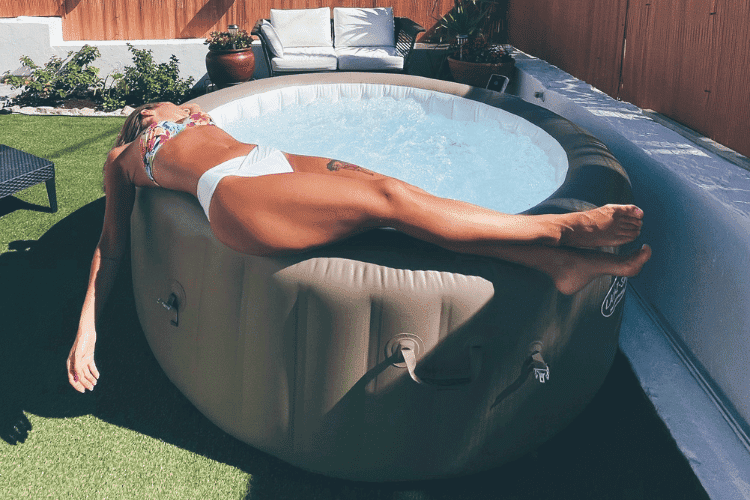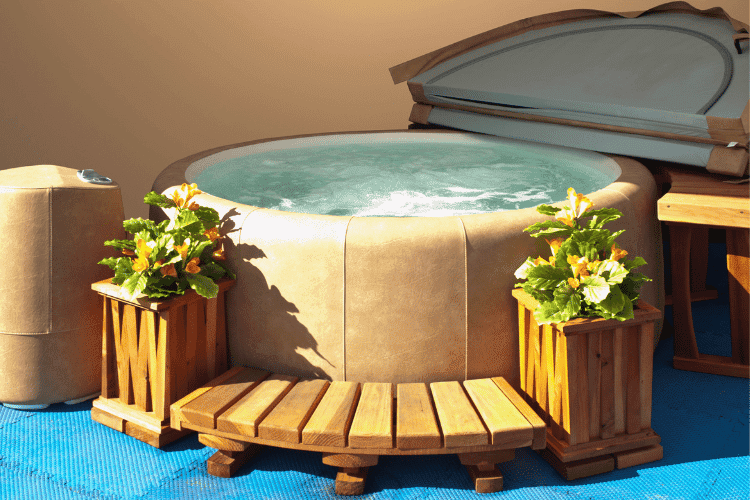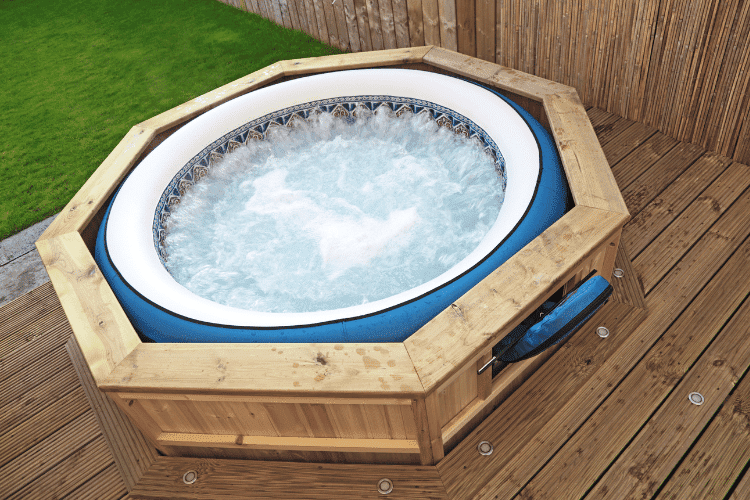Insulating your inflatable hot tub helps maintain the water temperature, reduces energy consumption, and enhances overall comfort. By adding a layer of insulation, you can keep the heat in and the energy bills low.
One effective insulation method is to add thermal or solar blankets on top of the water and below the hot tub cover. Other options include using partial foam or splurging for custom insulation.
In this guide, we’ll provide step-by-step instructions on how to insulate the tub walls and base effectively. Get ready for an energy-efficient and cozy hot tub experience!

Why Insulating an Inflatable Hot Tub is Important
To achieve an energy-efficient hot tub and make the most of your investment, you need to insulate your inflatable hot tub. Otherwise, you’re wasting energy by constantly heating it more.
Additionally, insulating an inflatable hot tub offers a multitude of benefits that’ll enhance your overall spa experience. Let’s dive into why proper insulation is crucial:
1. Less Heat Loss
Without insulation, your hot tub can lose heat quickly, especially during chilly summer mornings or in the winter months. By adding a layer of insulation, you can minimize heat loss and keep the water warm and inviting for a longer time.
2. Additional Comfort
Insulation not only keeps the water warm, but creates a cozy and comfortable environment as well. It helps retain the heat within the tub, allowing you to fully relax and enjoy your soak without feeling chilly.
3. Increased Lifespan
Because proper insulation prevents heat loss, it’ll protect your inflatable hot tub from potential damage caused by extreme temperature fluctuations. By reducing stress on the tub’s components, insulation can contribute to extending its lifespan.
4. Energy Efficiency
Insulating your hot tub enhances its energy efficiency since it reduces the amount of heat required to maintain the desired temperature. This means lower energy consumption and reduced operating costs over time.
How to Externally Insulate an Inflatable Hot Tub
In this section, we’ll explore various external insulation options, such as insulating covers and thermal blankets.
While picking an option from below, remember that the goal is to enhance insulation efficiency, maintain water temperature, and create a more enjoyable hot tub experience.
1. Insulated Covers
Insulated covers are a popular and practical option for external insulation. They’re specifically designed to trap heat and prevent energy loss.
Not only that, but these covers typically feature a durable, insulating material that acts as a barrier, keeping the warmth inside your hot tub. Look for covers with a high R-value too, which indicates superior insulation properties.
That said, some covers may require periodic maintenance, such as cleaning or treating, to ensure longevity and prevent mold or mildew growth.
2. Thermal Blankets
Thermal blankets are another great option for insulating your inflatable hot tub. These blankets are made from insulating materials that provide an additional layer of warmth and help retain heat.
Plus, they’re easy to install and can be custom-fit to your hot tub’s size. Thermal blankets are particularly useful during colder months as well, or if you plan to use your hot tub less frequently.
Keep in mind, though, that thermal blankets may not be as durable as other insulation options and may need occasional replacement due to wear and tear.
3. Partial Foam Insulation
Some inflatable hot tub models come with partial foam insulation. These tubs have foam-filled sections integrated into the walls, providing enhanced insulation and heat retention.
But how does it work?
The foam acts as a barrier, reducing heat loss and making your hot tub more energy efficient. So if you’re considering purchasing a new inflatable hot tub, look for models with this feature for improved insulation.
It’s important to note here that partial foam insulation may increase the overall weight of the hot tub, making it slightly more challenging to move or transport.
4. Custom Insulation Options

If you’re looking for a more comprehensive insulation solution, you can explore custom options such as inflatable spa enclosures or insulating wraps.
These solutions provide additional insulation by creating an enclosed space around your hot tub, minimizing heat loss and maximizing energy efficiency. They can be particularly beneficial in colder climates or for extended use during winter.
However, custom insulation solutions can be relatively expensive and may require more time and effort for installation and maintenance.
How to Insulate the Walls of an Inflatable Hot Tub
Properly insulating the tub walls helps maintain optimal water temperature and reduces energy loss.
This insulation step, combined with the external insulation options mentioned earlier, will create a well-insulated hot tub that retains heat effectively and provides a comfortable spa experience all year round.
So, here’s a step-by-step guide to effectively insulating the tub walls:
1. Select Insulating Materials
The material you choose should be suitable for inflatable hot tubs. You can pick from foam panels or insulating sleeves since they’re excellent, extra layers of insulation.
That’s because these items minimize heat transfer between the water and the surrounding ambient temperature.
2. Clean and Dry the Tub
Before applying the insulation, ensure that the tub walls are clean and dry. Remove any dirt or debris to create a smooth surface for the insulation materials to adhere to.
3. Install Foam Panels or Sleeves
Cut the foam panels or sleeves to fit the shape and size of your hot tub walls. Attach them securely to the tub using adhesive or straps, ensuring they cover the entire surface.
4. Seal Any Gaps
Inspect the edges and seams of the foam panels or sleeves to identify any gaps or openings.
Use appropriate sealants or adhesives to seal these areas, preventing air leakage and further enhancing insulation efficiency.
5. Pay Attention to the Winter Season
During colder months, consider installing an additional insulating layer to further protect your inflatable hot tub.
Thermal blankets or insulating covers, for example, can help maintain water temperature and reduce heat loss—particularly in harsh winter conditions.
How to Insulate the Base of an Inflatable Hot Tub
Insulating the base of your inflatable hot tub helps prevent heat loss through the bottom, enhances energy efficiency, and ensures a more comfortable spa experience.
Here’s how you can effectively insulate the base:

1. Prepare the Ground
Start by preparing the ground where you’ll place your hot tub. Make sure the surface is clean, level, and free from sharp objects that could potentially puncture the tub.
2. Insulating Ground Mats
Consider using insulating ground mats specifically designed for hot tubs. These mats create a thermal barrier between the tub and the ground, minimizing heat transfer. They’re often made of closed-cell foam as well, which offers excellent insulation properties.
Floor protection and heat insulation
Suitable for all surfaces
Non-slip and easy clean
Suggested read: What To Put Under An Inflatable Lay-Z Spa
3. Thermal Barrier Materials
Alternatively, you can use thermal barrier materials, such as insulating foam boards or reflective insulation, to cover the base of your hot tub. These materials provide additional insulation by reflecting heat back into the tub, reducing energy loss.
4. Secure the Insulation
Make sure the insulating ground mats or thermal barrier materials are properly secured to the base of the tub. Use straps or adhesives to hold them in place if necessary, and ensure they cover the entire bottom surface.
How to Properly Seal an Insulated Hot Tub
Proper sealing and air circulation are vital for maintaining the insulation efficiency of your inflatable hot tub. This ensures better temperature retention, reduces energy loss, and creates a healthier spa experience.
Some key considerations to ensure a tight seal and healthy air circulation include:
1. Check for Air Leaks
Regularly inspect your hot tub for any air leaks that may compromise insulation. Always check the valves, seams, and connections.
If you find any leaks, use a repair kit or sealant to fix them promptly. After all, a tight seal helps retain heat and stop any energy loss.
Simple and easy to apply
UV resistant
Conforms to irregular surfaces
2. Maintain Adequate Air Circulation
While sealing is crucial, it’s equally important to promote healthy air circulation within the hot tub – especially if yours is indoors.
That’s because proper air circulation prevents condensation and reduces the risk of mold growth. As such, keep the vents or air inlets unobstructed and periodically clean the filter to optimize airflow.
3. Preventing Condensation
In colder weather, condensation can occur due to the temperature difference between the water and the surrounding air.
To minimize condensation, consider using a dehumidifier or opening the cover slightly to allow excess moisture to escape. This helps maintain a comfortable and dry environment.
Energy-saving
Automatic shut-off and full tank indicator
Extra drain hose for continuous drainage
Conclusion
In conclusion, proper insulation is essential for inflatable hot tubs so you’re able to maintain water temperature, reduce energy loss, and enhance your overall spa experience.
Start by insulating the tub walls and base, then implement external insulation options. This helps create a well-insulated hot tub that’s energy efficient and comfortable to use.
Additionally, by sealing air leaks and promoting air circulation, you can optimize the performance of your hot tub while minimizing energy costs.
Implement our insulation techniques to enjoy a cozy and enjoyable spa experience, no matter the season! For more queries on hot tubs, check out our other articles here.







